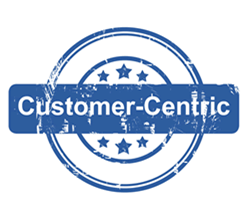The above image is a demonstration of the stages a product goes through during its lifetime. Economics and MBA students probably recognize this, although the progression and decline curve rarely translates to reality in the way it’s portrayed.
See that there are 4 major phases that a business cycle goes through:-
- The business starts its operations and sees little growth.
- The product blows up and starts experiencing sharp growth.
- The rate of growth becomes stagnant, which is sustainable.
- Product sales start to decline gradually.
These phases are business paradigms that call for different measures and strategies at different times during its life cycle. The evolution of marketing strategies in respect to these phases is termed as Product Life Cycle Management.
But Why Look at Product Marketing through the Lens of Life Cycle?
Product Life Cycle Management is important mainly because it helps you plan and manage all aspects of your product, which further helps you derive your product marketing strategies. And that mainly does 2 things:-
- Reduces Costs
When you understand what phase your business is in, you will not bother spending funds to improve segments where there is no scope of improvement. - Maximizes Profits
It’s easy to maximize your profits when you know where to allocate your funds. Knowing what phase your business is in will bring awareness to those areas of improvement.
These are the 2 things that businesses mainly care about, and when you understand which phase of the business life cycle you’re in, you understand how to communicate effectively with your audience.
To communicate effectively is to “meet people where they are”, for which you need to develop a buyer persona. When you spot the early signs of the upcoming transition into a new phase, you can suggest how your marketing campaigns should accommodate that change.
Phase #1 – Introduction

When your product is either about to launch, or just hits the market, that’s when you are in the introduction phase. These types of businesses need to be spreading awareness and inducing their target market to buy their products or services.
How Product Marketing Works Here
You can’t expect your product to be accepted by your customers right away because chances are that your competitors already have a basic version of that product, and you can’t compete with someone who already has social proof.
The Introduction phase calls for more investments initially because nobody knows about your product yet. Your spending should be towards spreading awareness, which you can start by giving out product trials and heavy discounts.
Research Requirements
Had you been in any other successive phase, you’d already have enough customer feedback to be able to derive the needs and concerns of your target market. You can either rely on your competitor’s user research (if you’re able to get your hands on one), or hire Market Research experts to do that for you.
Here are a few questions you need your market research team to answer about your competitors:-
- Why did they create this product?
- What all problems does it solve?
- How big is their market reach?
- Who are their intended buyers?
- List of potential users or companies who are influential in this space.
Once you have these answers, you’ll be able to figure out the most effective channels for product marketing, specific to your business.
Phase #2 – Growth

You’ll realize you’re in the growth stage when the sales start to shoot up in quantity and in a lot less time, but more so than that, you have market presence. You’ll be thinking about rising above your competition.
You can start investing your time and efforts in organic business growth. It’s your competitors who will shape your product marketing strategies during the Growth stage.
Product Marketing Strategy
You’ll realize you’re in this phase when instead of trying to get more customers, you’ll be thinking about rising above your competition, and it’s your competitors who will shape your product marketing campaigns during the Growth stage.
During this period, your priority is to maximize your market share and build brand preference. Here’s where your marketing team needs to get innovative.
Research Requirements
When you have consumers buying your product back and forth, you will have enough feedback to go ahead and understand your consumer needs first-hand, which is what your product marketing strategies will be based on as well.
That is a lot more nuanced than planning strategies based on speculated consumer attitudes and behaviours like you did in the first phase. This is where you need to conduct a bit of qualitative research.
Instead of objective facts that you already have, you need to get down to their subjective experiences and analyze them. That addresses very specific concerns and oftentimes, help you come up with innovative solutions.
Qualitative research can come from several sources like live chat transcripts, one-to-one customer interviews, on-site surveys, etc. the goal of which is to:-
- Creating different user archetypes.
- Split testing different product updates.
- Prioritization of meaningful product updates.
Phase #3 – Maturity
This is it. You’re finally in the big leagues. I’d like to describe this phase with a Star Wars reference:-

How high you are in that apex league depends on your business performance and achievements during the Growth phase, and how long you will be in the Maturity phase, depends on how well your marketing team is.
Product Marketing Strategy
The strategies that worked in the previous 2 phases aren’t going to cut it anymore, because you have competition on both ends of the spectrum – the ones who offer your alternative, but cheaper, and the ones who offer a higher-end version of your product.
Good news is, you can reduce your marketing costs without impacting your business. However, your overall strategy in this phase is to maximize profit while maintaining your current market share.
The product marketing strategy you should employ is to establish a brand identity. Gone are the days when you could stand out in terms of features because you’ve done that for years and beyond a point, every company starts to look the same when they’re all offering those features.
If there’s one thing that no one can beat, it’s your brand, the trust that you’ve garnered over the years will always pay off, as long as you can maintain it. A good example in a B2B industry would be Hubspot, or OnePlus if we’re talking B2C. They both rose to prominence in a highly competitive market and are currently only focusing on maintaining a brand image.
Research Requirements
This phase is a risk-averse paradigm. Here, you look for possibilities that can cause the company’s market share to decline, because you’re already at the top, and will continue to grow with the data you garnered from the research in 1st and 2nd phases.
Although, for a scale of research this big, businesses usually rely on third-party research and advisory firms like Gartner and Forrester, who can help you suggest which direction the market is moving towards.
A firm this successful is bound to have a large sales team. You can conduct research on your sales team to understand if there are any pain points, which makes the research conducted in the Growth phase a lot more elaborate.
Phase #4 – Decline

Have other companies started catching up with you? Taking away your customers? Pushing you to cut your profit margins? Has your product become a commodity that’s easy to come by? Well, these are all signs that you’ve entered the decline phase.
Product Marketing Strategy
You need to keep on investing in your brand more and start milking the brand-take the largest possible profit from an item in the shortest amount of time and effort. The only difference is that you also need to cut down on some of your spendings.
Since your net income is declining and your expenses aren’t, you have to manage your expenses where you abandon processes and strategies that aren’t yielding sustainable results.
This doesn’t mean you abandon the idea of getting new clients. In fact, you have to set your target to earn money from laggards (the people who are yet to adopt your brand) so that you have more money to invest in your brand. The priority from this point is your brand identity.
Research Requirements
- Identify the laggards – Find people who are taking time to finalize your brand as their go-to, for the product and service you offer. Adding a new demographic or expanding an existing one can slow the downturn in sales.
- Find most expensive marketing channels – Remember, your goal is to acquire more customers, and when you can afford high Customer Acquisition Costs, you can acquire more customers and recover from brand milking.
Wrapping Up
If you’re a business that’s having a hard time understanding what phase they’re in-which usually happens in phases 2 and 3-the best way to figure that out is to imagine the next stage and try to work your way backward.
- If you just began your business, how will your value proposition and market strategy operate in an oversaturated marketplace, or when you’re competing with industry leaders?
- If you’re in the Growth phase, how are you differentiating your product beyond just features? Is your brand-building strategy good enough?
- If you’re in your Maturity phase, what is your strategy to avoid Declining? Can you bring efficiency into your demand generation campaigns and improve profitability?
Product marketing forces you to become proactive and helps you understand what’s coming next, and what research efforts you need to make in order to yield the best results.
Digital & Social Articles on Business 2 Community
(42)
Report Post




